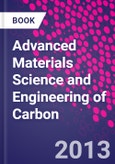Carbon materials are exceptionally diverse in their preparation, structure, texture, and applications. In Advanced Materials Science and Engineering of Carbon, noted carbon scientist Michio Inagaki and his coauthors cover the most recent advances in carbon materials, including new techniques and processes, carbon materials synthesis, and up-to-date descriptions of current carbon-based materials, trends and applications.
Beginning with the synthesis and preparation of nanocarbons, carbon nanotubes, and graphenes, the book then reviews recently developed carbonization techniques, such as templating, electrospinning, foaming, stress graphitization, and the formation of glass-like carbon. The last third of the book is devoted to applications, featuring coverage of carbon materials for energy storage, electrochemical capacitors, lithium-ion rechargeable batteries, and adsorptive storage of hydrogen and methane for environmental protection, photocatalysis, spilled oil recovery, and nuclear applications of isotropic high-density graphite.
Please Note: This is an On Demand product, delivery may take up to 11 working days after payment has been received.
Table of Contents
Introduction
- Carbon nanotubes: synthesis and formation
- Graphene: synthesis and preparation
- Carbonization under pressure
- Stress graphitization
- Glass-like carbon: its activation and graphitization
- Template carbonization: morphology and pore control
- Carbon nanofibers via electrospinning
- Foaming of carbon (including exfoliation)
- Nanoporous carbon membranes
- Carbon materials for electrochemical capacitors
- Carbon materials in lithium-ion rechargeable batteries
- Carbon materials in photocatalysis
- Carbon materials for spilled heavy oil recovery
- Carbon materials for adsorption of molecules and ions
- Highly-oriented graphite with high thermal conductivity
- Isotropic high-density graphite for nuclear applications
Conclusions
Authors
M. Inagaki Professor Emeritus, Hokkaido University, Japan.
Michio Inagaki, Ph.D. is a famous carbon material scientist, who obtained his PhD degree from Nagoya University in 1963. He has worked on carbon materials for more than 50 years. In 2011, he won the Peter A. Thrower Award for Exceptional Contribution to the International Carbon Community. Feiyu Kang Professor, Department of Materials Science and Engineering, Tsinghua University, China.
Feiyu Kang received his PhD from The Hong Kong University of Science and Technology in 1997. He is honorary editorial advisory board of international journal CARBON, Joint Chairmen of international symposiums: CARBON2002 (Beijing), Carbon2011 (Shanghai) and 15th International Symposium on Intercalation Compounds (ISIC15), Coordinators of international research projects: Professor M. Inagaki (NSFC-JSPS) and Professor I. Mochida (JST-MOST).
Prof. Kang has investigated graphite and carbon materials since 1988. His research interest includes nano-carbon materials, graphite producing process, porous carbon and nuclear graphite. Prof. Kang had published more than 200 scientific papers and 3 books. Masahiro Toyoda Oita University, Japan. Hidetaka Konno Hokkaido University, Japan.








